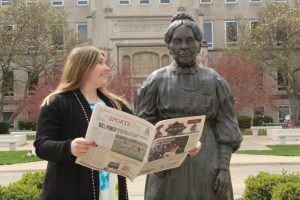Every year, Feb. 2 is the day that we finally learn how long winter is going to last.
But how we figure that out just baffles me. Every year, groundhogs all over North America emerge from their burrows to check their shadows.
If Punxsutawney Phil does not see it, there will be a short winter (two weeks more) or if he sees it, the winter will be long (six weeks more).
The reason this signals when winter will end is because if a groundhog sees its shadow, it will return to its burrow because winter is going to continue on for longer. If it does not see its shadow, it leaves its burrow for good.
This year, the most famous groundhog, Phil, did see his shadow and returned to his burrow, which means a long winter. And over the course of the day, seven groundhogs did not see their shadows and nine did. The consensus is a short winter from our rodent comrades.
The closest such event to Peoria is in Edwards at Wildlife Prairie State Park, where Gertie the Groundhog is the keeper of our winter destiny.
This year, he gave us bright prospects for spring’s arrival when he left his burrow after his shadow was not visible.
For living in a world filled with cures for the strangest diseases and a logical reason for almost everything that has happened on this planet, even before people existed, using this tradition to determine winter’s length is ludicrous.
The reason this occasion is still a newsworthy occurrence baffles me. All other holidays possess the opportunity for money to be made or have a major religious significance.
Although Groundhog Day falls on Candlemas, which is a Catholic holiday that marks the end of Epiphany season, Candlemas isn’t a very celebrated holiday.
My question is why does Groundhog Day exist today?
When Groundhog Day originated in the 17th century, it had practical purposes. Farmers used it to determine when to plant their crops and, as time went on, our world has become exponentially more logical and intelligent.
We are at the point that we can predict when rain will arrive almost to the exact time of day from a week in advance. Yet this day is still considered a national holiday.
All Groundhog Day represents is a different time than ours, a time when science was a rough estimate.
Today, people still find interest in what groundhogs think about the changing of seasons enough to make it one of the top searches on Yahoo! on Tuesday.
This old-school way of thinking makes me believe either people want an almost nostalgic feeling of when life wasn’t so busy, or they actually believe this method of predicting is correct.
Using this logic, I think that if my cat eats four or more separate times on the Sunday before opening kickoff, the NFC team will win the Super Bowl every year.
My point to writing this is to say that we are lucky to live in a time when we have almost anything at our disposal.
We can pretty much lay out the next decade of our lives if need be, yet trying to determine the arrival of the next season by way of rodent is preventive to growth as a society.
Bill Hopkins is a sophomore sports communication major from Oswego. He is the Scout sports editor.
Direct comments, questions and other responses to whopkins@mail.bradley.edu.



